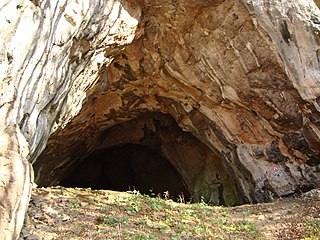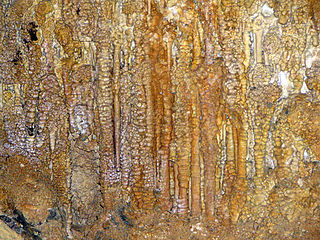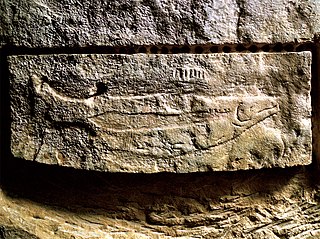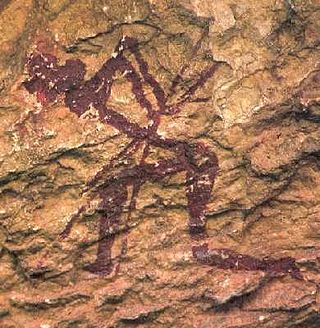
Cro-Magnon is an Aurignacian site, located in a rock shelter at Les Eyzies, a hamlet in the commune of Les Eyzies-de-Tayac-Sireuil, Dordogne, southwestern France.

Shanidar Cave is an archaeological site on Bradost Mountain, within the Zagros Mountains in the Erbil Governorate of Kurdistan Region in northern Iraq. Neanderthal remains were discovered here in 1953, including Shanidar 1, who survived several injuries, possibly due to care from others in his group, and Shanidar 4, the famed 'flower burial'. Until this discovery, Cro-Magnons, the earliest known H. sapiens in Europe, were the only individuals known for purposeful, ritualistic burials.

Wildkirchli are three interlinked caves situated in the Alpstein massif in the Appenzell Innerrhoden canton of Switzerland, north-east of Mount Säntis Switzerland. The caves are located at a height of 1,477–1,500 m (4,846–4,921 ft). They are notable for the traces of Paleolithic Neanderthal habitation, dating to c. 40,000 BP, and cave bear bones dating to 90,000–40,000 BP. A museum at the site houses a full bear skeleton that was found in one of the caves.

Karain Cave is a Paleolithic archaeological site located at Yağca Village 27 km (17 mi) northwest of Antalya city in the Mediterranean region of Turkey.

Azykh Cave, also referred to as Azokh Cave, is a six-cave complex in Azerbaijan, known as a habitation site of prehistoric humans. It is situated near the village of Azykh in the Khojavend District.

Quinson is a commune in the Alpes-de-Haute-Provence department in southeastern France.

Drachenhöhle or Drachenhöhle Mixnitz is a 542 m (1,778 ft) long cave with a 20 m (66 ft) wide and 12 m (39 ft) high entrance near Mixnitz, Styria, Austria, south-east of Bruck an der Mur located at an elevation of 950 m (3,120 ft) above sea level. Cave bear of the species and other bone fossils that people found during the Middle Ages were deemed to be the bones of dragons, a belief that culminated in the saga of the "Dragon slayer of Mixnitz". The cave is one of the largest caves in the Alps where bears occupied an area that stretched over a length of way over 500 m (1,600 ft), by an average width of up to 40 m (130 ft) and a height of 10 to 15 m.

Risovača Cave, is situated at the very entrance of the town of Aranđelovac in central Serbia around 17 m (56 ft) above the Kubršnica river valley. It is one of the most important archaeological sites of the Paleolithic in Serbia besides the Gradac Cave near Kragujevac. Its discovery confirmed the assumed existence of the Paleolithic culture south of the Sava-Danube line and provided new information on the life of prehistoric humans in Europe.

The Prehistoric Sites and Decorated Caves of the Vézère Valley is a UNESCO World Heritage Site in France since 1979. It specifically lists 15 prehistoric sites in the Vézère valley in the Dordogne department, mostly in and around Les Eyzies-de-Tayac-Sireuil, which has been called the "Capital of Prehistory". This valley is exceptionally rich in prehistoric sites, with more than 150 known sites including 25 decorated caves, and has played an essential role in the study of the Paleolithic era and its art. Three of the sites are the namesakes for prehistoric periods; the Micoquien, Mousterian, and Magdalenian. Furthermore, the Cro-Magnon rock shelter gave its name to the Cro-Magnon, the generic name for the European early modern humans. Many of the sites were discovered or first recognised as significant and scientifically explored by the archaeologists Henri Breuil and Denis Peyrony in the early twentieth century, while Lascaux, which has the most exceptional rock art of these, was discovered in 1940.

The prehistory in the Valencian Community refers to the period from the Paleolithic, including the appearance of the first populations, until the appearance of colonizing peoples, in the territory of the Valencian Community.

Grimaldi man is the name formerly given to two human skeletons of the Upper Paleolithic discovered in Italy in 1901. The remains are now recognized as representing two individuals, and are dated to ca. 26,000 to 22,000 years ago and classified as part of the wider Early European modern humans population of the late Aurignacian to early Gravettian.
Mezmaiskaya Cave is a prehistoric cave site overlooking the right bank of the Sukhoi Kurdzhips in the southern Russian Republic of Adygea, located in the northwestern foothills of the North Caucasus in the Caucasus Mountains system.
Ras El Kelb is a truncated seaside cave and Paleolithic settlement located on the low-lying coast of Lebanon, 8 km (5.0 mi) north of Beirut. It is one of the oldest habitations found in the country.

The Mladečské Caves are a cave complex in the municipality of Mladeč in the Czech Republic. It is located in the Třesín National Nature Monument within the Litovelské Pomoraví Protected Landscape Area.
The Obi-Rakhmat Grotto is a Middle Paleolithic prehistoric site that yielded Neanderthal fossils. It is a shallow karst cave near the junction of the Chatkal and Pskem Rivers at the southwestern end of the Talassky Alatau Range in the Tien Shan Mountains, 100 km (62 mi) northeast of Tashkent, Uzbekistan.

Okladnikov Cave is a paleoanthropological site located in the foothills of the Altai Mountains in Soloneshensky District, Altai Krai in southern Siberia, Russia. The cave faces south and is located on a Devonian karst escarpment, lying about 14 metres (46 ft) above the left bank of the Sibiryachikha River valley below; the river itself is a tributary of the Anuy River.

Pešturina is a cave in the municipality of Niška Banja in southeast Serbia. It is located southwest of Jelašnica and 20 km (12 mi) southeast of Niš. Artifacts from the Middle and Upper Paleolithic periods were discovered since the archaeological excavations began in 2006. The remains, identified as the Mousterian culture, were dated from 111,000 BP+ 5,000 to 39,000 BP + 3,000, which makes Pešturina one of the latest surviving Neanderthal habitats. The cave has been nicknamed the "Serbian Atapuerca".

The Cave of Pego do Diabo is a small karst cave in a Turonian limestone outcrop located about 250 metres above sea level in the municipality of Loures, about 20 km north of Lisbon in Portugal. The erosion of the outcrop resulted in a set of openings in the rocks wide enough to be exploited by humans. Several archaeological studies have been conducted within the cave, which give insights into the duration of Neanderthal presence on the Iberian Peninsula and to the presence of carnivorous animals during the Paleolithic.
Sakajia Cave Natural Monument is a karst cave located 1.5 km to the north-east from village Godogani, Terjola Municipality in Imereti region of Georgia, 204 meters above sea level. It is located on the left slope of the scenic Tskaltsiteli Gorge across the river from Motsameta monastery, 1.5 km southwest. Many important archaeological, paleobotanical and paleozoic discoveries has been made in the cave.

Balanica is a cave complex and paleoarchaeological site in the City of Niš' municipality of Niška Banja in southeast Serbia. It consists of Velika Balanica and Mala Balanica. The entrances of two caves are 7 m (23 ft) apart, at an elevation of 329 m (1,079 ft), and form one cave system. A third cave, Pešturina, is also nearby. The two Balanica caves extend parallel to each other, likely being connected at the rear.


























